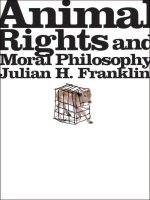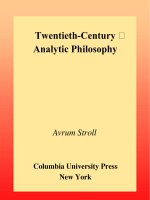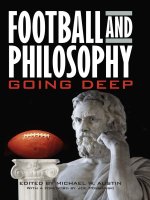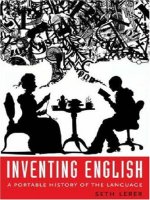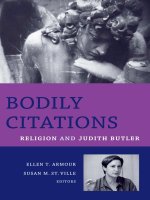columbia university press bodily citations religion and judith butler jun 2006
Bạn đang xem bản rút gọn của tài liệu. Xem và tải ngay bản đầy đủ của tài liệu tại đây (2.41 MB, 336 trang )
BODILY CITATIONS
GENDER, THEORY, AND RELIGION
GENDER, THEORY, AND RELIGION
Amy Hollywood, Editor
The Gender, Theory, and Religion series provides a forum for interdisciplinary
scholarship at the intersection of the study of gender, sexuality, and religion.
Martyrdom and Memory: Early Christian Culture Making
elizabeth a. castelli
When Heroes Love: The Ambiguity of Eros in the Stories of Gilgamesh and David
susan ackerman
Abandoned to Lust: Sexual Slander and Ancient Christianity
jennifer wright knust
Women, Men, and Spiritual Power: Female Saints and Their Male Collaborators
john coakley
BODILY
CITATIONS
RELIGION AND JUDITH BUTLER
Edited by
Ellen T. Armour
and
Susan M. St. Ville
COLUMBIA UNIVERSITY PRESS
NEW YORK
COLUMBIA UNIVERSITY PRESS
Publishers Since 1893
New York, Chichester, West Sussex
Copyright © 2006 Columbia University Press
All rights reserved
Library of Congress Cataloging-in-Publication Data
Bodily Citations : religion and Judith Butler / edited by Ellen T. Armour and Susan M. St. Ville.
p.
cm.
Includes bibliographical references and index.
isbn 0-231-13406-1 (cloth : alk. paper) — isbn 0-231-13407-x (pbk. : alk. paper) —
isbn 0-231-50864-6
1. Religions. 2. Butler, Judith. 3. Feminist theory. 4. Sex role—Religious aspects.
5. Gender identity. I. Armour, Ellen T., 1959– II. St. Ville, Susan M., 1963–
bl410.b63 2006
202.082--dc22
2005034516
Casebound editions of Columbia University Press books are printed
on permanent and durable acid-free paper.
Printed in the United States of America
c 10 9 8 7 6 5 4 3 2 1
p 10 9 8 7 6 5 4 3 2 1
CONTENTS
Preface and Acknowledgments vii
Introduction xiii
Judith Butler—in Theory 1
ellen t. armour and susan m. st. ville
TEXTUAL BODIES
1. Materializations of Virtue: Buddhist Discourses on Bodies 15
susanne mrozik
2. The Garden of Eden and the Heterosexual Contract 48
ken stone
3. The Annoying Woman: Biblical Scholarship After Judith Butler
teresa j. hornsby
EMBODYING IDENTITIES
4. Disturbingly Catholic: Thinking the Inordinate Body 93
karen trimble alliaume
71
VI
CONTENTS
5. Unconforming Becomings: The Significance of Whitehead’s Novelty
and Butler’s Subversion for the Repetitions of Lesbian Identity
and the Expansion of the Future 120
christina k. hutchins
6. Turning On/To Ethics 157
claudia schippert
7. Agency, Performativity, and the Feminist Subject 177
saba mahmood
THEORIZING BODIES
8. “Judith Butler” in My Hands 225
rebecca schneider
9. Performativity, Citationality, Ritualization
amy hollywood
Afterword 276
judith butler
Selected Bibliography 293
List of Contributors 297
Index 299
252
PREFACE AND ACKNOWLEDGMENTS
T
HOUGH NOW CONSIDERABLY expanded, this volume originated
from a set of sessions sponsored by the Feminist Theory and
Religious Reflection Group at the 1997 national meeting of the
American Academy of Religion in San Francisco. The group took advantage of
the meeting’s location to invite feminist and queer theorist Judith Butler, professor of rhetoric and comparative literature at the University of California in
Berkeley, to respond to a set of papers by scholars of religion in various fields
using her work. Professor Butler graciously agreed, and two dynamic sessions
with a combined audience of several hundred took place. The response to
those sessions and the important place that Professor Butler’s work continues to occupy in women’s studies, queer theory, and disciplines that engage
those fields (including religion) inspired us to produce this anthology.1 While
we expect this book will find an audience among scholars in religion who
are already interested in Butler, we also hope to attract scholars of religion
who are not familiar with—or may even be skeptical about—her work. In
addition, we hope that the book will appeal to scholars of feminist and queer
theory who may be unaware of—or even skeptical about—religious studies.
A word or two, then, to entice both kinds of readers into the volume.
VIII
PREFACE AND ACKNOWLEDGMENTS
THE TROUBLE WITH GENDER (AND BEYOND)
Though not her first book, the publication of Gender Trouble: Feminism
and the Subversion of Identity in 1990 brought Judith Butler to prominence.2
Gender Trouble broke new ground in feminist theory and became a founding text in the emerging field of queer theory with its assertion that gender
produces sex. Masculinity and femininity, Butler argued, are bodily performances based on the demands of our heterosexual and phallocentric economy, not expressions of the body’s inner nature. In monographs that followed, Bodies That Matter (1993), Excitable Speech (1997), and The Psychic
Life of Power (1997), Butler refined and expanded upon Gender Trouble by
developing more detailed accounts of the mechanisms through which identities are produced and resisted while attending to the political contexts in
which they function.3 In recent years Butler has turned her attention to kinship structures (Antigone’s Claim: Kinship Between Life and Death, 2000) and
international politics (Contingency, Hegemony, Universality, 2000, co-written
with Slavoj Žižek and Ernesto Laclau), including America’s responses to September 11 (in Precarious Life: The Powers of Mourning and Violence, 2004).4
Her latest book, Undoing Gender (2004), returns once again to the fraught
terrain of sexuality and gender nearly twenty-five years after Gender Trouble.5
Her investigations into all these arenas continue to explore and expose the
interplay of psychic, linguistic, and political forces.
The essays in Bodily Citations focus on Judith Butler’s performative theory of gender, the aspect of her work that continues to exercise the greatest
influence on academia. We have provided in “Judith Butler—in Theory” an
account of the contours of this theory and its significance for the study of
religion; what follows here positions this volume in relation to critical questions raised about Butler’s theory. Even those who have never read a word
of Gender Trouble may be aware of the brief firestorms of controversy that
have erupted around Butler in the public press in recent years. A review of
Butler’s major works written by Martha Nussbaum for the New Republic
(February 22, 1999) is a case in point.6 Although in our judgment Nussbaum’s
review has been rightly critiqued as unnecessarily vicious and irresponsible,
it seems to us important to address.7 Doing so provides a useful entrée into
critical questions about Butler’s work that are raised and, in some cases,
addressed in Bodily Citations. Nussbaum accuses Butler (as have others
before) of substituting the doing of supposedly subversive things with words
for genuine feminist political engagement. Elevating language to center stage
distorts reality and troubles structures foundational to political activism, she
argues. Stable identities (including that of being a woman) and the ability
to act freely—both notions challenged by Butler’s work—seem to be basic
requirements for any kind of politics, feminist or otherwise. Engaging with
PREFACE AND ACKNOWLEDGMENTS
IX
Butler, Nussbaum claims, results inevitably in a paralyzing quietism that
eviscerates feminist politics.
The questions Nussbaum raises echo what seem to be lingering—if
uninformed—suspicions about not only Butler’s work but certain kinds of
theory on which it depends. What does theory of the type Butler engages
(psychoanalytic, deconstructive, poststructuralist) offer those who struggle
with hardscrabble political realities? Butler, like the theorists on whom she
draws, has been accused of resorting to jargon-laden prose that some deride
as camouflage for weak ideas. Are the insights to be gained from submerging oneself in what is purported to be, at least, inscrutable prose and convoluted ideas (or convoluted prose about inscrutable ideas) worth the intellectual labor?
The introduction to Butler’s work that follows will, we trust, effectively
put to rest suspicions based on misunderstanding or misreading of this theorist. Many of the essays will shed new light on those questions that need
serious consideration. Indeed, examining the uses to which religionists put
Butler’s work strikes us as an excellent location for responding to these questions and suspicions. Though itself frequently subject to oversimplification
in the popular media and the secular imagination (the religious imagination,
too, for that matter), religion is an aspect of culture that has its moments of
high theory and its hardscrabble realities. Those of us who have taken it up
as an academic pursuit are perhaps especially attuned to the complexities of
religious ideas and their materializations in religious texts and practices of
various sorts engaged in by perfectly ordinary people to ordinary and extraordinary effect. Even those who go about their lives paying little or no attention
to religious matters cannot avoid their effects. For good and for ill, religious
traces persist even within the West’s putatively secular culture—overtly as a
source of conflict (as in the so-called culture wars) but also covertly (as the
unacknowledged root of certain cultural traditions). Religion, like gender and
sexuality (and often with them), is a site where language, materiality, theory,
and politics all come together in complex ways.
PUTTING BUTLER TO WORK
In addition to deepening and broadening our understanding of the
import of Butler’s work, Bodily Citations offers a distinctive approach to the
study of religion by applying a common theoretical lens to a set of issues that
emerge from diverse religious sites. The introduction to this volume describes
the essays in more detail. We take a moment here to provide readers who are
unfamiliar with the academic study of religion with a map that situates each
essay in relationship to that field.
X
PREFACE AND ACKNOWLEDGMENTS
This volume deploys a rather broad understanding of the study of religion.
While most of the authors of these essays hold PhDs in religious studies, two
are trained in other fields. Dance and performance studies scholar Rebecca
Schneider turns to religious ritual and the embodied practice of female performance artists to refine challenges to Butler’s views on the body, knowledge, and agency. Anthropologist Saba Mahmood draws on her research on
an urban women’s mosque movement in Cairo to argue for greater nuance
in theorizing agency. Religious studies scholar Amy Hollywood continues in
this vein by arguing that a deeper consideration of religious ritual and ritual
theory could strengthen Butler’s account of performativity.
The remaining essays in this volume are drawn from subfields generally
representative of religious studies (biblical studies, theology, ethics, and the
history of religions). Theologians and ethicists working out of Christian traditions use Butler’s work to craft creative responses to contemporary challenges. Claudia Schippert begins to articulate a queer religious ethics modeled on womanist ethics, a model that allows her to build on Butler’s work
on normativity. Karen Trimble Alliaume appropriates Butler’s theory of performativity to renew and reframe debates over the Roman Catholic Church’s
insistence that the ordained must be, like Jesus, physically male. Christina
Hutchins uses Butler’s work to analyze the rather complex subject position of
“the lesbian minister.”
Scholars in biblical studies and the history of religions use Butler’s work
to read sometimes troubling sacred texts. Biblical scholars Teresa Hornsby
and Ken Stone draw on Butler to craft approaches to the Bible that are able
to contest its use against those deemed “other” because of gender or sexuality. Hornsby inquires after the strategies that sustain and undercut feminist
approaches to biblical studies and proposes her own reading of the nameless
prostitute in Luke’s gospel. Stone offers a queer reading of the creation stories in Genesis, traditionally cited in support of heterosexuality’s normative
status, exposing textual ambiguities that undercut that usage and open up
other possibilities. Butler’s work allows Susanne Mrozik, a scholar of Buddhism, to uncover resistances to normative associations between masculine
embodiment and virtue in the Indian Buddhist story of Rupavatı.
¯ ¯ ¯
That scholars in religious studies are open to engaging Butler’s work
reflects a characteristic of the study of religion in general. Aptly described
as interdisciplinary, scholars of religion in all of its subfields frequently apply
methods and theories drawn from various disciplines in the humanities and/
or social sciences. However, we have asked the contributors to this volume to
do more than simply apply Butler’s theories to their own scholarly projects.
Tat-siong Benny Liew, in his response to Queer Commentary and the Hebrew
Bible, calls for biblical scholars not just to use queer theory but also to “interrogate, or even transform queer theory. . . . After all, what would entice a
Judith Butler or a Michael Warner to read our work if we are just demon-
PREFACE AND ACKNOWLEDGMENTS
XI
strating over and over again the ‘correctness’ of their formulations?” (185–86).
We could not agree more and would extend his admonition to include all
scholars of religion who use any theory—particularly those theories that have
developed in order to attend to marginalized others. Each of these essays was
selected because its author “speaks back” to Butler. That is, in addition to
deploying Butler to good effect in analyzing various aspects of religion, these
scholars also raise questions about, pose challenges to, extend and/or deepen
Butler’s own work from the perspective of the study of religion. We are grateful that Professor Butler has, in fact, not only been enticed to read the essays
contained herein but has written a response to the volume as a whole. Appropriately, for the moment at least, the last word belongs to her.
Some material in Karen Trimble Alliaume’s essay appeared in earlier form in
“The Risks of Repeating Ourselves: Reading Feminist/Womanist Figures of
Jesus” Cross Currents (Summer 1998) 48, no. 2 (sscurrents.
org/alliaume.htm).
“Performativity, Citationality, Ritualization,” by Amy Hollywood, is reprinted by permission from History of Religions 42, no. 2 (2002): 93–116, originally published by University of Chicago Press.
“Unconforming Becomings: The Significance of Whitehead’s Novelty and
Butler’s Subversion for the Repetitions of Lesbian Identity and the Expansion of the Future,” by Christina Hutchins, is reprinted by permission of
Process and Difference: Between Cosmological and Poststructuralist Postmodernisms, ed. Catherine Keller and Anne Daniell (New York: State University
of New York Press, 2002). Copyright © 2002 State University of New York.
All rights reserved.
Saba Mahmood’s essay is based on material that first appeared in Politics
of Piety: The Islamic Revival and the Feminist Subject (Princeton University
Press, 2005). We thank Princeton University Press for permission to use this
material.
A portion of Rebecca Schneider’s essay appeared in “Taking the Blind in
Hand,” Contemporary Theatre Review 10, no. 3 (2000): 23-38, and is used here
by permission from Routledge Press. The journal’s Web site may be accessed
at .
Ken Stone, “The Garden of Eden and the Heterosexual Contract,” is from
Take Back the Word: A Queer Reading of the Bible, ed. Robert E. Goss and
Mona West (Cleveland: Pilgrim, 2000), 57–70. Copyright © 2000 by the Pilgrim Press. Revised by permission.
Funds provided by the R. A. Webb Professorship at Rhodes College
helped make this project possible. The editors are grateful to Rhodes College
for its support.
XII
PREFACE AND ACKNOWLEDGMENTS
NOTES
1.
2.
3.
4.
5.
6.
7.
For a sample of the monographs and anthologies by scholars of religion that use
Butler’s work, see the bibliography at the end of this volume. Note that they
come from most subfields of religious studies including theology, ethics, history
of religions, and biblical studies.
Judith Butler, Gender Trouble: Feminism and the Subversion of Identity (GT). For
complete references to books authored by Butler (either alone or with others),
see the bibliography at the end of this volume. All citations of these texts in the
essays that comprise this volume will be referenced in abbreviated form using
the abbreviations given in the bibliography.
Judith Butler, Bodies That Matter: On the Discursive Limits of “Sex” (BTM); Excitable Speech: A Politics of the Performative (ES); The Psychic Life of Power: Theories in Subjection (PLP).
Judith Butler, Antigone’s Claim: Kinship Between Life and Death (AC); Judith
Butler, Ernesto Laclau, and Slavoj Žižek, Contingency, Hegemony, Universality: Contemporary Dialogues on the Left (CHU); Precarious Life: The Powers of
Mourning and Violence (PL).
Judith Butler, Undoing Gender (UG).
Martha Nussbaum, “The Professor of Parody,” New Republic 220, no. 8 (February
22, 1999): 37–45.
Warren Hedges, Gayatri Chakravorty Spivak, Seyla Benhabib et al., “Martha
Nussbaum and Her Critics: An Exchange,” New Republic 220, no. 16 (April 19,
1999): 43–45.
INTRODUCTION
O
UR PREFATORY ACCOUNT of Butler’s work has begun to indicate, we trust, its rich and varied potential as a resource for
scholars of religion. Indeed, the essays gathered here reflect
in their complexity the many directions this intersection can take. Multiple
themes run through and overlap in these pieces. For heuristic purposes we
have grouped these essays into three sections representing the main topics
of textual interpretation, agency and religious subjectivity, and prospective
theoretical directions. The essays, however, refract each other in varied ways
and so, in Butlerian fashion, could be grouped and regrouped to provoke still
further avenues of inquiry.
TEXTUAL BODIES
We begin with three articles that draw on Butler to interpret religious
texts, in each case finding unexpected meanings in works that have been
influential in both Eastern and Western religious traditions. Susanne Mrozik,
a scholar of Buddhism, reviews the Sanskrit tale of Rupavatı, a narrative that
¯ ¯ ¯
in its unfolding offers teaching on what is required to attain a virtuous state.
XIV
INTRODUCTION
Mrozik finds useful analytical resources in Butler’s theories of the materialization of bodies via the citational process as well as in the production of
the abject. Appropriating these insights for her own purposes, she critically
reassesses the formation of “virtuous bodies” as these are exemplified by the
Buddha and his precursor the Boddhisatva. Mrozik’s creative reappropriation
works to uncover unexpected depths in Butler’s views as she extends them to
fit Buddhist contexts, allowing her to produce interpretations that challenge
normative assumptions in Buddhism that routinely equate the ideal of virtue
exclusively with the male body.
As Mrozik reminds us, the attainment of Buddhahood evolves through
a process of birth and rebirth. The story of Rupavatı outlines three succes¯ ¯ ¯
sive lifetimes of the founder of Buddhism. The tale is particularly useful for
Mrozik because it offers multiple accounts of sexed bodies and their alterations. To point to only a few, the Buddha first appears in this story in the
form of a woman, Rupavatı (Beautiful Woman). In the course of the narrative
¯ ¯ ¯
Rupavatı, in an act of generosity, mutilates her body by cutting off her breasts
¯ ¯ ¯
to feed a starving mother. Her breasts are eventually restored only to be lost
again when she is reborn as a Beautiful Man (Rupavata), and as successive
¯ ¯ ¯
male Boddhisatvas, in the end attaining Buddhahood. While traditional readings have interpreted Rupavatı ’s excision of her breasts as a moment when
¯ ¯ ¯
her body becomes male (thus in line with the ideal that equates virtue with
the male body), Mrozik sees in this mutilation an embracing of the abject
and the emergence in Rupavatı’s altered form of alternatively sexed beings.
¯ ¯ ¯
With this reading in place, the way is opened for a proliferation in interpretations of the Buddha as, in Mrozik’s terms, “omnibodied” and for a more fluid
reconceptualization of the Buddhist community as well.
Authors Ken Stone and Teresa Hornsby draw on Butler’s writings to interpret the Hebrew Bible and New Testament respectively. Stone focuses his
attention on the two creation accounts found in Genesis. Noting the tendency of queer critics to concentrate on undermining biblical passages that
explicitly condemn homosexuality, Stone takes a different tack. He argues
rather for the importance of calling into question those texts like the creation
stories that, while silent on homosexuality, exert force by working to establish
and secure the norms of binary sexual difference and compulsory heterosexuality. His review of the priestly account in which God creates humans
in the divine image as male and female demonstrates the ways the text has
prompted biblical interpreters as disparate as Karl Barth and Phyllis Trible to
find a divine sanction in sexual dimorphism. When Stone turns to the Yahwist
account, however, he follows Butler’s interpretive lead to locate instabilities
and ambiguities in the text that call into question the totalizing reach of the
Scriptures’ assumed heteronormativity. In this passage, where God first creates a single human being who only later is divided into two, Stone suggests
INTRODUCTION
XV
questions of sex and gender are more ambiguous than most interpreters have
acknowledged. Stone finds, for example, in the undefined sex of the initial
human creature a space where alternative models of subjectivity might proliferate. His reexamination of these central scriptural passages leads Stone
finally to a consideration of the task of queer biblical interpretation and the
transformative effects that are opened, in this case for gay male readers who
continue to engage and be shaped by these texts.
In “The Annoying Woman: Biblical Scholarship After Judith Butler,”
Teresa Hornsby considers the ways in which Butler’s insights raise the stakes
for feminist biblical interpretation. Butler’s observation that even our most
subversive actions emerge from the web of cultural discourses and so are
prone to unwittingly perpetuate its ideologies leads Hornsby to question what
remains possible for feminist biblical interpretation. She explores this question through a consideration of Luke 7:36–50 in which an unnamed woman
anoints the feet of Jesus. While Hornsby is drawn to the powerful physical
and erotic overtones of this story, she observes that traditional interpretations routinely cast the woman as a prostitute or as otherwise guilty of sexual
transgression or excess. Further, feminist scholars have been no more effective in finding positive value in this figure. More commonly, they have critiqued Luke for undermining the anointing woman by casting her as silent,
nameless, and subservient. In so doing, Hornsby charges, feminists reinforce
reigning assumptions that equate silence with powerlessness, overlooking
the force of the woman’s physical actions and the possibility that a more radical meaning might be found in her seemingly subordinate stance.
To chart a different course, Hornsby uses interpretive tools exemplified
in Butler’s reading of the classic Antigone story. Like Antigone, she suggests,
the anointing woman can be viewed as a liminal figure who because of her
very anonymity cannot easily be placed in the social structure. Butler cautions against the desire to fill in the outlines of such an undefined figure and
in so doing to seek a representative model for behavior. Rather she recognizes the lack of definition as opening a space for the generation of unexpected possibilities.
For Hornsby, viewing the silence of the anointing woman in this way
draws attention more fully to her actions, particularly to the erotic physicality
or desire that plays between the woman and Jesus. Where earlier interpretations skirt this aspect, or note it only to quickly condemn or restrain it,
Hornsby is able to call it to the fore. She demonstrates how this desire works
in the text to give the lie to the stability of social and sexual standards that
have heretofore held place. Still, Hornsby ends with a cautionary reminder
that her own reading, too, functions as a performance that is subject to unexpected appropriations. Though her reading cannot then effect a full-scale
revolution, its disruption of norms makes a beginning.
XVI
INTRODUCTION
EMBODYING IDENTITIES
The four papers comprising the middle section of the collection use
Butler in different ways to ponder questions of agency. In “Disturbingly
Catholic: Thinking the Inordinate Body” Karen Trimble Alliaume critically
analyzes orthodox Catholic teachings against women’s ordination as well as
feminist responses or challenges to the magisterium. She finds Butler useful
as she untangles the “web of symbolism” that links Jesus’s corporeal body
to the constitution of the corporate body of Christ that is the Church and
does so in such a way that women, precisely because of their bodies, are
excluded from leadership roles. Tracing how “gender matters” in the formation of Roman Catholic women, Alliaume suggests that Butler helps us to
see the full extent of the violence inflicted on women through the Church’s
teachings. She observes that at its deepest levels Christianity is structured
according to a “logic of imitation” wherein Christ stands as the model believers must mimic in order to be saved. And yet, given Catholicism’s official
insistence on gender complementarity, this is an imitation from which
women will always fall short.
In her article Alliaume details how this logic of imitation marks the magisterium’s teaching that priests must be male because only men can adequately
resemble the male Christ. Still further, she contends that feminist challenges
to this teaching unwittingly continue to employ its underlying logic when
they advocate copying the humanity of Christ. Following Butler, Alliaume
then turns to imagine the possibilities that open when the relationships
between Christ, believers, and the church are rethought according to a logic
of citationality. Such an emphasis shifts attention from the figure of Jesus,
which is rooted in the past, to the ongoing communal process of seeking to
both follow and reembody the living Christ. It is sustained by the recognition that it is through these citations that Jesus’s body, as well as the bodies
of believers, is continually materialized. As with all performative processes,
Alliaume observes, the re-citation of Christ would be marked by an openness to multiple and unexpected redeployments—in this case to the multiple
ways in which Jesus could be re-presented by Church leaders to the faithful. Such an openness, she suggests, offers renewed pathways for women’s
agency within Catholicism.
Christina K. Hutchins writes “Unconforming Becomings” in the context
of debates over the inclusion of gays and lesbians in Christian church communities. As she notes, these often contentious discussions have brought
concreteness to issues of identity politics more often discussed in the
abstract. As a minister in the United Church of Christ and as a lesbian,
Hutchins is well aware of the immediacy of these questions. She frames her
INTRODUCTION
XVII
article with reflections on the ambivalence she feels when asked to speak as
a representative of gay members of her church. Hutchins traces this discomfort to the fact that such efforts at inclusion tend to assume an essentialist
understanding of gay identity that, however defined or understood, is inherently reductive and inevitably reinforces a binary opposition between homosexuals and heterosexuals. She is thus led to explore the alternative models
of subjectivity proposed in Alfred North Whitehead’s process metaphysics
and Judith Butler’s theory of performativity. While there are important differences between these thinkers, Hutchins finds in both a vision of the subject that both honors engagement with concrete experiences and emphasizes
openness to change and renewal. These more fluid models of identity, she
asserts, avoid or deconstruct the binarisms of essentialism that fund the logic
of exclusion. Furthermore, both theorists locate the subject’s agency in what
Butler terms its capacity for “subversive resignification.” Significantly, both
characterize this tendency of the subject toward the unexpected in positive
terms as a movement toward or capacity for pleasure.
With these models of subjectivity in hand, Hutchins proceeds to articulate the implications they hold for a theologically disclosive politics of inclusion. While it is important to maintain identity categories (e.g., lesbian) so
that visibility is secured, she argues that it is equally important to highlight
the instabilities of all identities. By giving full and public recognition to the
incompleteness in their midst, religious institutions become part of the movement that enables structural transformation. Hutchins moves beyond Butler (though with Whitehead) to claim that this dynamic process evidences
the presence of a holy and creative love. She concludes with the suggestion
that the process leaves believers with dual directives of responsibility and
hope. Responsibility resides in the call to remain attentive to possibilities
for change in the face of an unexpected future. Hope in turn is found in the
excess that lies always beyond what is actualized.
Claudia Schippert finds in Butler’s writings a valuable resource as she
begins to envision the shape a queer ethics might take. Against those critics
who have discounted Butler’s usefulness for ethics because she deconstructs
the voluntarist subject, Schippert argues that performativity provides an alternative form of agency that can fund the moral decision making of those who
are rendered invisible by the dominant culture. In particular she highlights
suggestions in Butler’s texts that the realm of the abject holds open such possibilities. To build on those suggestions, Schippert conducts a rereading of
Katie Cannon’s womanist ethics through a Butlerian lens. She finds in Cannon’s description of the moral wisdom of African American women a realization of the radical promise that might reside in a realm that both exceeds
and forms the “constitutive outside” of the dominant culture. Suggesting that
XVIII
INTRODUCTION
a queer ethics can be developed along parallel lines, Schippert offers the
phrase “taking on the abject” to describe its character. As the dynamic constitutive of queer moral agency, “taking on” connotes both embracing that
which is excluded and countering that which is normative. Such agents,
and this ethics, Schippert imagines will function according to “a different
geometry,” one more akin to that evidenced in black holes where what is
invisible exerts decisive influence.
Anthropologist Saba Mahmood takes up the question of agency in the
context of her study of a contemporary women’s mosque movement that
is part of the Islamic revival in Egypt. Movements such as this—in which
women intentionally engage in practices from study to prayer to veiling in
order to cultivate more modest and pious selves—have most often been dismissed by Western feminists as examples of the repressive reach of religious
conservatism. To Mahmood, however, such critiques reveal more about liberal conceptions of freedom and agency that have predominated in feminist theory than they do about the subjectivity forged by the women of the
mosques. She turns to Butler’s performative subject as a model that is better
able to honor the historical specificity of this movement. At the same time,
her ethnographic research rooted in Islamic women’s descriptions of their
desires, practices, and goals sheds a critical light, revealing blind spots and
gaps in Butler’s theory. She notes, for example, that in her writings Butler
tends to develop the concept of agency primarily in the context of supporting resistance against social norms (e.g., her reading of drag’s significance).
Yet Butler neglects to articulate other ways beyond conformity or conflict
in which subjects come to inhabit social structures. Mahmood deepens her
critique of Butler by suggesting that the gaps in her theory result in part from
Butler’s tendency to conceptualize performativity in terms of signification.
She sketches a broader notion of performativity informed by ritual theorists
and Aristotelian notions of habitus, which she contends is better able to capture the nuances of the bodily practices and disciplines of the women in the
mosque movement that enable the cultivation of a particular subjectivity.
Mahmood’s analysis carries implications for contemporary feminist theorists as well as a broad range of scholars of religion. Recognizing that our
conceptual formations have been decisively shaped by a progressive political agenda leads to important questions: what is elided from view by these
formations, and what forms of implicit and explicit violence are wrought as
a result on those whose lives are not shaped in accord with Western political ideals? Mahmood’s article serves as a call to keep feminist political and
analytical work open to challenges arising from the multitude of socially
specific sites. As she observes, this call is of particular importance in this
historical moment when religious difference takes such a prominent and
problematic place in international affairs.
INTRODUCTION
XIX
THEORIZING BODIES
We conclude with two pieces more directly concerned with theoretical questions posed to Butler, particularly as these center on the controversial relationship between the discursive and material realms. Rebecca
Schneider’s training as a scholar of performance studies allows her a unique
perspective from which to reflect on the status of language and the body in
Butler’s theory of performativity. She does so through a close reading of Butler’s 1997 Qui Parle article “‘How Can I Deny That These Hands and This
Body Are Mine?’” and a passage in Excitable Speech in which Butler interprets a traditional folk parable.
In the Qui Parle article Butler takes up Descartes’ reflections on doubt,
writing, and the body in order to answer critics who charge that her own
work dissolves the material body. Butler argues convincingly in the article
that she, like Descartes, has not done away with the body but rather continually finds its trace in and through her writing. Yet Schneider continues
her inquiry to ask about the status of the body Butler has retrieved. She
notes that while Butler’s article claims to examine the dynamic of writing
and reading, her focus is primarily on writing. As a result, the body Butler
finds remains elusive, the specter of the hand that writes but that remains
always at a distance.
To Schneider Butler’s concentration leaves aside other modes in which the
body is known and encountered in language. These modes are represented
by the act of reading wherein Butler herself suggests those who take up a text
are “compelled” to reperform its language. To explore these occluded possibilities, Schneider turns to a brief passage in which Butler comments on a
folk tale retold by Toni Morrison as a parable about writing and reading. In
the tale a group of children attempt to trick an elderly blind woman by asking
her whether a bird they are holding is alive or dead. The woman responds,
“I do not know—what I do know is it is in your hands.” Following Morrison’s
reading, which portrays the woman as a writer, Butler interprets her response
as highlighting the blindness of writing, the fact that once written the writer
(and her body) stand at a remove from the text (itself a body) and its fate.
When Schneider takes this parable into her own hands, however, she finds
an alternative interpretation, one that evokes the existence of a form of “tactile knowing” using the text. Here the writer’s body moves through the spoken word to touch the children, evoking and underscoring the significance of
their own bodily, in-handed response.
This evocation of another relationship of the body to language as well as
another form of knowledge, Schneider suggests, can also be seen in the work
of performance artists who seek to challenge and break down the timeworn
distinction between theater, with its disembodied spectator, and the more
XX
INTRODUCTION
participatory practice of ritual. Such an understanding of body and language,
which is indebted to yet moves beyond Butler, holds promise for religious
studies, not only in its reflections on ritual as a mode of knowledge but also
in considering more fully the embodied character of religious texts.
Amy Hollywood likewise attends to Butler’s attempts to answer those who
accuse her of granting excessive power to language. She observes that Butler’s response hinges on her claim that language is performative and as such
materializes rather than eliminates the body. Further, Butler suggests that it is
through ritualized bodily practices as well as speech acts that subjects come
to be. Still, Hollywood notes, critics remain unconvinced in part because
these rituals, when theorized at all by Butler, tend to be construed along the
lines of the theory of performative linguistic utterances she has adopted from
J. L. Austin. Thus, her treatment seems to return the body to the realm of
language. Hollywood seeks to provide a fuller account of ritual and bodily
practices that could clarify Butler’s theory of performativity and reduce its
vulnerability to the charge of inadequately accounting for the material.
To accomplish this task, Hollywood reviews the understanding of ritual
found in Austin and Derrida, two main influences on Butler’s thought. For
Austin, rituals stand as prime examples of what distinguishes performative speech from ordinary constative speech. While constatives mean what
they say via the sign’s similarity to the signified independent of context and
speaker, rituals do not. The power of the ritual is context dependent, Austin argues; it resides in its ability to recite conventions and in the speaker
who performs and authorizes it. Derrida challenges Austin’s attempt to distinguish between constative and performative language on these grounds. As
structuralism claims, language is a system of signs arbitrarily connected to
what they signify by convention. Thus all language is performative. So-called
constative language’s ability to mean what it says is, like all rituals, dependent on iterability and ultimately lies outside the control of the speaker. The
resemblance between ritual and language goes the other way as well. The
arbitrariness of language extends to all rituals, Derrida argues. Thus, strictly
determining the external context that authorizes a ritual is ultimately impossible. Rather, performatives constitute or generate their own contexts in the
process of enactment.
Hollywood draws on Derrida to outline a view of ritualization that places
bodily practices at the heart of the reiterative process. Derrida’s account of
performativity enables a more nuanced theory of the bodily actions of ritual
practice that can address problems in Butler’s thought. Thinking ritual and
language together would allow Butler to develop her claim that the body is
materialized in language in such a way that the two are neither strictly separate nor reducible to each other. Such a move would provide theoretical bal-
INTRODUCTION
XXI
last to her ongoing insistence that the force of the performative resides in the
body and constitutes it as a potential site of resistance. Hollywood’s reflections also extend and deepen theories of ritual offered by religious studies
scholars such as Talal Asad and Catherine Bell. To acknowledge the arbitrariness that shapes the intersection of language and the body as affecting belief
and practice underscores the potential inherent in ritual to “misfire” and thus
contribute to the development of new and unexpected religious subjects.
BODILY CITATIONS
